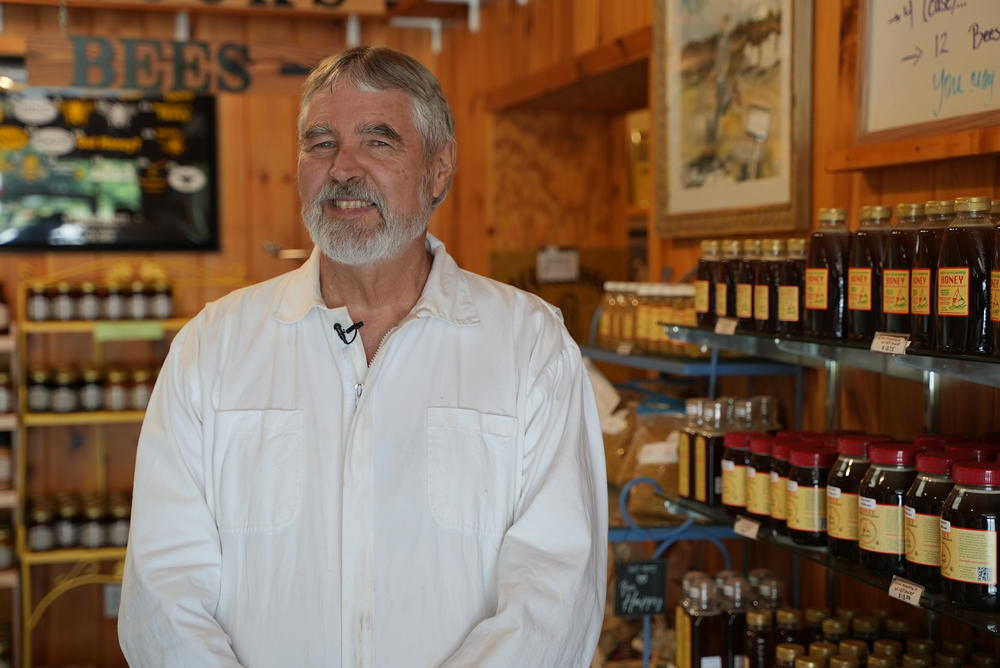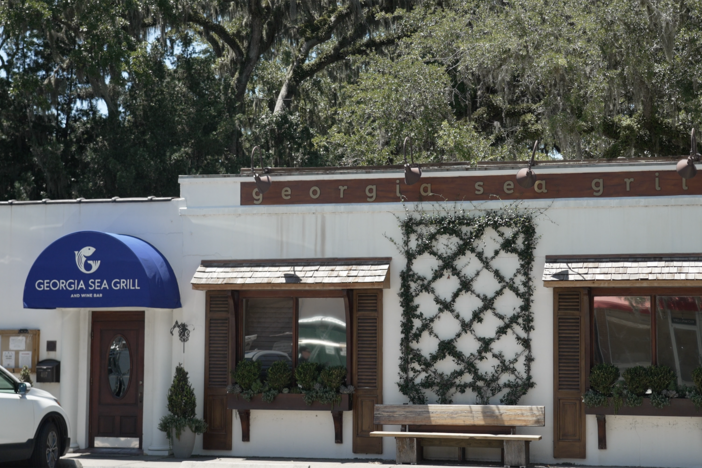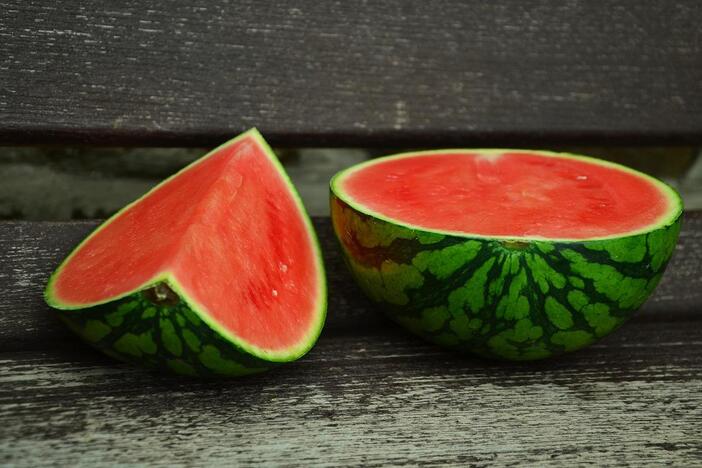
Section Branding
Header Content
A Fork in the Road Podcast: Buzzing in Blue Ridge
Primary Content
Join host David Zelski on an enlightening journey through the world of honey and beekeeping in this special episode of the Fork in the Road podcast. Visit the Blue Ridge Honey Company in the beautiful mountains of North Georgia to meet veteran beekeeper Bob Binnie, whose 40 years in the industry have given him unique insights into the production of honey and the health of bee populations. Discover how honey bees are vital to our food system, learn about the various types of honey and their benefits, and explore the intricate processes behind honey production. Get to know the UGA Honeybee Lab team and their critical research to combat the Varroa destructor, the tiny yet devastating mite threatening bees worldwide. From tasting local honey varieties to understanding the complexities of bee research, this episode offers a sweet and educational experience that will leave you buzzing for more.

Bob Binnie: They're extremely important. What a lot of people don't know. It's a lot of the food we eat came here from, Europe, other countries. And the pollinating insects that we have native to this country are not good pollinators for most of the food we need. And that's where honey bees come in.
David Zelski: In the honey business, sometimes the smallest things can become a big problem. Today we visit a honey farm, which works with scientists to help find a tiny bug whose widespread destruction has left a mark on the whole industry.
Theme Song: I came from the mud, there's dirt on my hands. Strong like a tree, there's roots where I stand.
David Zelski: I'm David Zelski, and this is the Fork in the Road podcast presented by Georgia Grown and the fine folks at Georgia Public Broadcasting. Each episode, we feature stories from Georgia's farmers, fishermen, merchants, artisans, chefs and others who help provide Georgia grown products to folks in the Peach State and beyond. Today, we're headed into the North Georgia mountains. About five miles north of Tallulah Falls is where we'll find Blue Ridge Honey Company in Lakemont, Georgia. This farm, located in the northeast Georgia portion of the beautiful Blue Ridge Mountains, is owned and operated by Bob and Suzette Binnie.
Bob Binnie: I've been here with Blue Ridge Honey Company in Lakemont, Georgia. Been in business as a beekeeper for about 40 years. We've been in this location for seven. We used to have a honey processing facility not very far from here. And seven years ago set up this, larger facility on 441 in Rabun County, which is a most north easterly county in Georgia. We are what is considered producer packers. Other words, we're beekeepers and we produce honey, but we also pack large amounts. We purchase honey from many other beekeepers that I know and trust. And, we have honey in several major chains: Kroger, Walmart and others. Last year we packaged about a million and a half pounds in the facility here. I honestly, I'm quite amazed that we do it. When you look at it, you'll see what I mean. It's not a large processing facility, but we pushed an awful lot of honey through here. In a good day, we can extract maybe 15 drums of honey, 55 gallon drums. These drums you see on the floor here, all full.
David Zelski: Honey connoisseurs will be dazzled by the options at Blue Ridge Honey Company.
Bob Binnie: Oh, the honey. Yeah, we usually have anywhere from 6 to 10 varieties. We always have a couple locals. The local honey that we have right now would be Mountain Wildflower and Sourwood, which are both produced right here in this county.
David Zelski: More on Sourwood honey later.
Bob Binnie: We have other honeys from Georgia like Gallberry and Tupelo and and others. And then we also, if you see the sign on the wall, we have honey from South Dakota, Michigan, Wisconsin, Florida, many other states. Those would be some of the ones we purchased from other beekeepers.
David Zelski: Bob is a 40 year veteran of the honey industry. He used to make his living out on the road, but these days he prefers to do his farming close to home.
Bob Binnie: Years ago, I used to travel a lot. I've had bees in as many as nine states, but these days I just stay in two states which would be western North Carolina and Georgia. I don't travel like I used to when I was younger. I'm kind of tired of that. Used to be highly migratory. I would start in California and then into Oregon and Washington state on to the Dakotas. And I've had bees in Wisconsin and South Dakota, North Dakota, California, Oregon, Washington, Florida, Georgia, North Carolina. So in past years, we did a lot of moving around. But I'm a little older now. I don't I don't care much for that. Living out of motels and trucks and traveling so much, we just stay close to home. Every bee yard that we have right now, I think there's 38 current bee yards, and they're all within 30 miles of this home location here. So I would no longer call myself a migratory beekeeper, although I did an awful lot of it when I was younger.
David Zelski: Having spent so many years in the industry, Bob has definitely gotten his fair share of stings. It's all part of the job. You build up an immunity to it?
Bob Binnie: I guess I do, or have I, you know, way back in the beginning, 40 years ago, I would swell up. But, there's days when we get stung a lot. And I'm not exaggerating when I say this, but there's days when we get stung a hundred times. We don't like it. You know, the more you get stung, the more sensitive you become. But we don't swell up or or have a bad reaction or anything with that many stings and that that's something that takes time. That doesn't happen overnight.
David Zelski: As with most honey producers, the busy season for Blue Ridge Honey Company is in the colder months.
Bob Binnie: There is the peak season. It's actually, the middle of winter. Christmas is a great time, oddly enough. Honey is a funny thing. I think a lot of sweet, sticky substances do the same thing. When it's very hot, sales drop. When it gets cold, and we get frosty nights, honey sales begin to pick up, and they stay that way until the next spring when the warm temperatures come back. It sells best in the winter. This warehouse is full of drums all the way to the back wall. At the peak of our buying season, which is probably around October or November, this place is so full you can't hardly move around. Kind of like a squirrel putting nuts away for the winter. We have to buy during the active season to get the product we want and pay the price we need to pay. And, the honey we have packed in here by November has to hold us until the following production season, which would be the first. Honey, we get in here is, Orange Blossom from Florida, which comes in in April. But most of the wildflower that we pack doesn't start coming in until May or June. So we will put a lot of barrels of honey in this warehouse before October is over.
David Zelski: And the great thing about storing honey? As long as it is stored properly, it doesn't spoil. The benefit to honey not spoiling.
Bob Binnie: Yeah. Honey doesn't. Honey doesn't spoil as long as the moisture content is correct. The magic number is about 18% moisture. If it's got more water than that, it will ferment if it hasn't been pasteurized. Honey is full of yeast, and if you don't heat it up to high enough temperature to kill the yeast it can ferment with high moisture. And we have seen that happen before.
David Zelski: Now, honey farming in a humid climate like Georgia has some very unique challenges.
Bob Binnie: The climate dictates your, your beekeeping practices. You know, the way we keep bees and Georgia's way different than it would be if, say, we were in Minnesota or if we went way south into Florida. In Florida the bees never really shut down. They raise brood all winter long. Whereas if you go to the far north, they shut down for quite a long time in the winter. We're kind of in the medium range here in the southern Blue Ridge mountains are being shut down in the winter and quit rearing brood for a few weeks, in late November and early December. So we're kind of in the middle of two extremes in our district. And our beekeeping practices reflect that. The way we feed our bees to get them through the winter is much different than somebody would need to do if they were, say, in Michigan or Canada or something like that. Parts of Florida, they may not ever have to address those kind of problems, because there's always something coming in down in Florida. So very different places need definitely very different practices. The bees do a pretty good job but in a high humidity area like Georgia or Florida sometimes they can struggle getting the moisture down below 18% before they cap it off. So we've actually seen cap honey that really didn't have a low enough moisture content. In a place like Arizona or California, New Mexico that's a non-issue because it's so arid there that, just the dry air will pull moisture out of honey.
David Zelski: Next up, the Fork in the Road vocabulary word of the day. Is that something we do, guys?
Bob Binnie: Honey is hygroscopic.
David Zelski: Hygroscopic. Adjective refers to the ability of a substance to absorb water from air molecules in the surrounding environment. Look at us. Learning together, huh?
Bob Binnie: If honey is continuously introduced to, humidity levels over 50 or 60%, it will gain water. It will gain weight. If you continually, have it exposed to humidities that are under 50%, it'll lose weight it'll lose water. So in Georgia, as you know, the humidity, we often wake up to 100 or 90% humidity here in this county. So we counteract that by bringing our crop into a room where we can dry it down a little bit before we extract it. We have a room that we put it in, and I'll show you that room. We try to pull a little bit of the moisture out before we extract. This rack that you hear over here is a large commercial dehumidifier. We have it running 24/7 during our extracting season. I don't know if you can feel it. This room is very dry. The humidity in here is very low. And we'll turn these fans off - on that are in the ceiling and drive that very dry air through our honey supers, and it'll tend to dry the honey out a little bit before we extract it. We're not trying to make it extremely thick, we just want a full 1 or 2 percentage points of water out before we extract it, to make sure that it's absolutely under that 18% moisture level.
David Zelski: Fork in the Road superfans will recall when I spent some time down in Homerville, Georgia, learning about the honey making process from Ben Bruce of Bruce's Nut and Honey Farm.
Ben Bruce: This is all about baby bees, and this is what you want to see now, because they're getting ready to make honey. Because all this stuff is fixin' to hatch out.
David Zelski: And if you haven't heard that episode, why don't you go back and take a listen now? You won't regret it. For a quick refresher, honey is what bees produce in order to store their food for the colder months. The food they're storing comes from flower pollen, and it's called nectar. Let's go back to Bob at Blue Ridge Honey Company.
Bob Binnie: When I speak to beekeeping associations, I like to pull kind of a trick question on them. I'll ask for the answer. What is the favorite food of honey bees? And of course, almost everybody will say 'honey, of course, why would you ask such a question?' But that's an incorrect answer. The favorite and best food for bees is actually fresh incoming nectar. What they do is they introduce these enzymes into nectar to change the chemistry, make it into something we would call honey, which is more stable. It's like taking their favorite food and making it into something that will store for a long time. Honey is is stable. Fresh nectar is not. And that's the reason for all this introducing of enzymes that changes the chemistry of fresh nectar.
David Zelski: And honey isn't just good for the taste buds, it's good for the whole body. A lot of people like honey for the taste. But there's also, health benefits involved. What have you learned through the years when it comes to the health and the reasons for honey?
Bob Binnie: Well, I could get on quite a soapbox about honey. Honey is very unique. It's not just another carbohydrate. Like some of the diet plans will lead you to believe. It's very unique. It has unique enzymes. And as long as you're, eating raw honey, you've got benefits that are hard to get from other foods. Raw honey is highly anti-microbial and antibacterial. And, so some of the enzymes in honey are really healthy. One of the ones that comes to mind is, the enzyme glucan, glucose oxidase, which produces glycolic acid and also has a byproduct of producing hydrogen peroxide. These elements in honey are highly antibacterial, anti-microbial, and provide some of the health benefits we experience with honey. And of course, if you get raw honey that hasn't been micro filtered, you get some of the fine particles of beeswax and pollen that are really healthy for us.
David Zelski: Honey isn't the only thing bees create which does the body good pollen. It's also filled with a surprising amount of health benefits.
Bob Binnie: Pollen has turned into a pretty big seller. A lot of people are getting interested in pollen as a as a health healthy supplement to their diet.
David Zelski: They put it in their smoothies?
Bob Binnie: Smoothies, salads, oatmeal. There's more protein in pollen per gram than probably anything on the planet. It's full of vitamins. It's it's really a a super concentrated food.
David Zelski: At Blue Ridge Honey Company, in addition to selling the honey and pollen produced by bees, they also use the wax which bees use to cap off their honeycombs.
Bob Binnie: This is our wax melter. We put our wax caffeine's in here, melt them down into blocks of wax like this that we sell. Most of our wax goes into candle making.
David Zelski: Why is the beeswax candle superior?
Bob Binnie: Well, they burn cleaner. They, they last a lot longer. Candle like this. This candle might burn 50 or 60 hours right here. Yeah. The big ones, the tall cylinders, which I don't see any on this shelf. The tall cylinders burn over 100 hours and they burn very clean. You don't get the scent that you do from paraffin. And they in some ways cleanse the air.
David Zelski: Besides all the wonderful products they make, bees also play a huge part in our entire system of agriculture. Without them, the produce section of your local grocery store would look much different.
Bob Binnie: They're extremely important. What a lot of people don't know is a lot of the food we eat came here from, Europe, other countries. And the pollinating insects that we have native to this country are not good pollinators for most of the food we eat. And that's where honey bees come in. They evolved with a lot of the food that came here. Our bees are European honeybees, basically. And so they're very good at pollinating the types of crops that have come here, you know, from the old country, so to speak. And, I've heard lots of numbers and thrown out there about, you know, what a grocery store would look like if the honeybees weren't involved. And my guess is about two thirds of the grocery, I know two thirds of the produce part of a grocery store would not exist if it wasn't for commercial honeybee pollination.
David Zelski: The lesson of this story. Protect the bees, y'all. To help with that mission, Bob donates bee colonies to the University of Georgia for research. That's where Jennifer Barry comes in. She's a research professor for at the University of Georgia honeybee Lab. Jennifer says the bee colonies Bob has donated over the years have been a huge help to their research.
Jennifer Berry: So I met Bob, gosh over 20 years ago, and since that time, he's been very generous in helping us donating colonies because a lot of time when we're doing research, we don't have a lot of money and colonies are expensive. So he'll donate colonies for us to use. He's given us a lot of colonies. He's helped us with equipment. He's helped us with labor. He's just been very generous.
David Zelski: And Bob says his partnership with UGA has been mutually beneficial.
Bob Binnie: I started with them doing that probably about '96 or '98, and I've done many studies with them throughout the years. It makes me feel good to donate my colonies for a worthy cause like that. And of course, it's not like I'm giving my colonies away. I get them back when it's over, and then, because I'm right there at the forefront, seeing the research done in person, I feel like I gain kind of a a little bit of wisdom that I might not have gotten just by reading the research paper. Being there and seeing it is really helpful for me. I try to learn as much as I can, and being a part of this UGA group really helps me that way.
David Zelski: Today, Jennifer and other members of the UGA Honeybee Lab are gathered in one of Bob Benny's bee yards to collect data for some very important research.
Jennifer Berry: So we have a limited crew up here in North Georgia collecting data on our colonies. But this is Jack Garrison. He's been at the UGA lab for seven years now, and he's really our backbone as far as being our beekeeper and helping collect data and the day to day operations of the bee lab. And then we have Ian, who's, newly graduate of University of Georgia. We have, three other students that are not with us today. They're down back at the lab cleaning. Fun work. Fun work. Yeah.
David Zelski: You could say Jennifer is shepherding the next generation of beekeepers. And these newcomers get to experience the good and the bad of the bee business.
Ian: I my second week here. Yeah, yeah, I'm going right into it.
Jennifer Berry: But his first. What was it your first week? He started working at the lab. He got stung. It was. We threw him into the pit of fire. I mean, it was. What does that saying going from.
Beekeeper: Ian went from 0 to 100.
Jennifer Berry: Yeah, 0 to 100. Like never been. Really. Well, he did a little bit of beekeeping in high school. In high school right.
Ian: A little bit but not really anything like this.
Jennifer Berry: But nothing. And then to full on colonies were stinging. We were doing colony assessments and you were getting stung on your back and he was getting anyway. Oh your ear. Yeah. And he's, he's hung out. Yeah. This is it's always a test. We always know. And actually, you know, we bring in students, and if they come back the next day, they're good.
David Zelski: Maybe cleaning the lab doesn't sound so bad after all. Now, all jokes aside, this group is doing extremely important work. They're looking to fight the spread of a tiny insect, which has become the single biggest problem for the bee population of the planet.
Jennifer Berry: So the number one reason our bees are dying is because of the exotic ectoparasitic mite called Varroa destructor. And once that came into the United States, it changed bees and beekeepers lives forever. It's not going to go away. It's something we're going to have to deal with.
David Zelski: The Varroa destructor isn't just a problem in the United States. It's the single biggest threat to bees in the entire world.
Jennifer Berry: Varroa is a worldwide problem. It once it jumped from Asia. Serana the Asian honeybee in Asia. Once it jumped to the western honeybee it moved across into Europe. It moved across Asia, moved across Russia, got into the European countries, and then it came into the United States. What they're doing is they're feeding on the developing bees as the bees are developing. And as that happens, they're kind of decreasing their immune system and allowing viruses that have always been there and have always been benign to be expressed. And it's the viruses that are killing our bees.
David Zelski: Much of the research done by the bee lab is testing out different miticides to find out which one will kill the Varroa mites, but not the bees.
David Zelski: Our research at the University of Georgia for the last 20 plus years has been looking at ways that we can control this mite without killing the colony, because basically, we're wanting to put an insecticide in a box of insects. And so we're trying to control, even though it's a mite we're trying to control a mite in a box of insects. So it's very difficult. There's a fine line there. What we're doing today is we're going to be testing this product. It's called Alien Cap, and it's an oxalic acid extended release material. And what it does is it's going to capture all of the mites over a 42 day period. So as bees are emerging from their cells, because that's where the mites are, they're going to be in the cells reproducing. And as the bees are emerging from the cells, hopefully they're going to be come in contact with this product, thereby killing them. And hopefully, hopefully we'll get some kind of good control. The lovely part about this particular product, oxalic acid, is found naturally in colonies in honey. It's also found in food that we eat like spinach, dark chocolate.
David Zelski: The oxalic acid the UGA Honeybee Lab team is applying to the honeycombs was only recently approved by the USDA for this purpose.
Jennifer Berry: When human consumable honey is on the colony, we can use this product. Right now, the majority of my two sides that we use to control Varroa cannot be used when human consumable honey is on a colony. That's what makes this product so our oxalic acid really beneficial to especially the commercial beekeepers that they can treat during times where mite loads are high and doing devastating effects on the colony. That's when we need to treat. And then the bees are going to kind of wipe, you know, wipe themselves or, move all around the material, getting the material on their bodies and then exposing it to the mites. And the mites are everywhere. Okay. They're on the adult bees, and they're also inside of the cap brood, but they could be crawling around on the frames, and that's what we're trying to get them exposed to is this oxalic acid material that we're going to put in.
David Zelski: Once the bees have been treated with colic acid, it's back to the UGA honeybee lab for analysis.
Jennifer Berry: So what we'll do is we'll take this back to the lab, and we are going to count how many bees are in this jar, and then count how many mites are in this jar. And that's going to give us a percent of infestation, percent rate of infestation. If, say, this jar has 100 bees in here and we find two mites, then that's a 2% infestation rate inside this colony. That's what this represents. Why we want this information is one for beekeepers, for our own use is to know when has the mite population reached the economic threshold. This is a really important number because this tells me, as the beekeeper, I need to treat.
David Zelski: Now, if this product is effective in killing the mites, Jennifer and the crew will present their results to the USDA and then have it certified for public use.
Jennifer Berry: If we find that it's very, works very good with decreasing mite populations and at the same time is not going to harm the bees, the developing baby bees, do a number on the colony. Then we will probably hand our data off to USDA and let them look at getting it registered for use in the United States.
Jennifer Berry: Because the acid is slow release, it takes 42 days to determine the results of the test.
Jennifer Berry: Beekeepers can put it into their colonies. They can leave it in for 42 days. The oxalic acid is going to be an extended release, slow release over time, exposing the mites to the oxalic acid, and then we will just pull the strips and throw them away environmentally. This is not I don't know if we will ever get organic approval, but it is not a toxic compound like an organophosphate which will stick around in the environment.
David Zelski: Now, seeing all these bees really gives me a hankering for honey. Let's visit Bob at the Blue Ridge Honey Company retail store for some samples.
Bob Binnie: So as you can see, we have these taster bottles where people can taste all the different varieties before they purchase. That makes it a lot easier for people to decide what they like. And all the honeys are unique. There's no two alike. Many people think that honey is honey, and that's not the case at all. The orange blossom is very distinct from, say, something like sourwood or clover.
Bob Binnie: Sourwood honey, you might not have heard of it, but it's one of the most delicious varieties of honey in the world. And you can only find it in the southeastern United States, particularly Appalachia.
Bob Binnie: So what is considered a Cadillac honey and goes for probably twice the amount of money of just normal Wildflower. Sourwood is kind of a southern Appalachian specialty. You really can't get it in other parts of the world. And it's a very, very good honey.
David Zelski: And if you'd like to try this, honey, you better be ready to drop some serious coin.
Bob Binnie: There's really a supply and demand problem with it, so it drives the price up. I'll give you an example of the price difference. If I was purchase purchasing an average wildflower, buy the semi load, which is about 65 drums, I might pay $225 or $235 a pound for it in my. If I'm buying sour, would I'd be paying $5 or $6 a pound for it. Quite a difference in price. Of course that's the bulk uncleaned just straight out of the extractor type of honey. By the time we process it, get it cleaned up a little bit, put it in jars that same wildflower might sell for $650 for a 1 pound jar. Sourwood might sell for $12. Quite a difference.
David Zelski: Jennifer can tell us more.
Jennifer Berry: This area usually gets really good sourwood, honey, a lot of produces a lot of good sourwood honey. But for whatever reason, this year, very little sourwood was produced in the North Georgia mountains. And it could have been because we had a lot of rain. It's Sourwood honey is, I think, one of the best honeys in the world. It has such a wonderful flavor, but it's very unpredictable year to year. And you're going to learn more about that when you go see Bob at Blue Ridge Honey Company.
David Zelski: For more stories like this one, you can watch A Fork in the Road on GPB-TV or any time on the GPB.org website. GPB.org/Podcasts is where you can listen to and subscribe to this podcast or download it on your favorite podcast platform.
I'm David Zelski. Thanks for listening to A Fork in the Road.
A Fork in the Road airs Saturdays at noon and Sundays at 6:30 a.m. on GPB-TV. Check your local listings for other replays throughout the week and watch all episodes anytime at GPB.org/ForkintheRoad. Please download and subscribe to the Fork in the Road podcast at GPB.org/ForkintheRoadpodcast or on your favorite podcast platform as well.

Join host David Zelski on an enlightening journey through the world of honey and beekeeping in this special episode of the Fork in the Road podcast. Visit the Blue Ridge Honey Company in the beautiful mountains of North Georgia to meet veteran beekeeper Bob Binnie, whose 40 years in the industry have given him unique insights into the production of honey and the health of bee populations. Discover how honey bees are vital to our food system, learn about the various types of honey and their benefits, and explore the intricate processes behind honey production. Get to know the UGA Honeybee Lab team and their critical research to combat the Varroa destructor, the tiny yet devastating mite threatening bees worldwide. From tasting local honey varieties to understanding the complexities of bee research, this episode offers a sweet and educational experience that will leave you buzzing for more.





